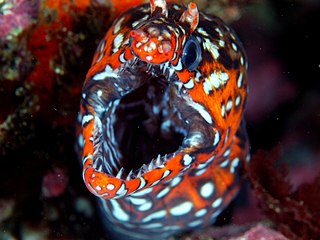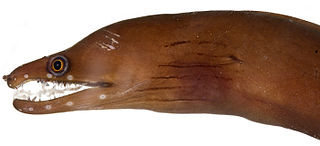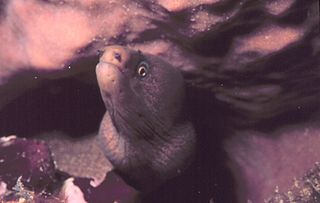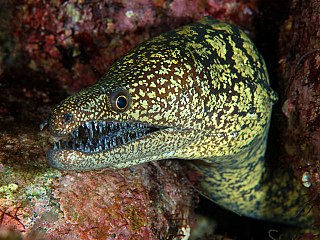
The mosaic moray is a moray eel of the genus Enchelycore, found in south-eastern Australia and around the offshore islands off Northland on the North Island of New Zealand at depths down to 100 metres, in reef areas of broken rock. Their length is between 40 and 180 centimetres, making them the largest known member of their genus.

Enchelycore is a genus of moray eels in the family Muraenidae. Enchelycore species are generally small to medium-sized eels, most ranging from 2 to 3 feet in length, with the largest being the Mosaic Moray, which reaches a length of 6 feet (180 cm). Members of the genus feature distinctive, curved jaws that prevent them from fully closing their mouth and aids them in catching, and holding on to prey. Enchelycore species can also feature extremely bright colors and ornate markings.

The Caribbean chestnut moray, Enchelycore carychroa, is a moray eel of the family Muraenidae.

The whitespotted conger is a marine conger eel, widespread in the Northwest Pacific near the coasts of Japan, Korean Peninsula, and the East China Sea. C. myriaster inhabits shallow sea bottom sand and mud. It is also consumed as food and is a common item on menus in Japan and abroad as anago. Its maximum total length is 100 cm.

The fangtooth moray sometimes also known as tiger moray or bird-eye conger is a moray eel of the family Muraenidae found in warmer parts of the eastern Atlantic Ocean, including the Canary Islands, Madeira and various other islands. It entered the Mediterranean Sea from the Atlantic and is now found occasionally in the eastern Basin, from Levantine waters and off Turkey, Greece, Croatia and Sicily.
The hookjaw moray, bowmouth moray, or Bayer's moray is a moray eel of the family Muraenidae. It is found throughout the Indo-Pacific as well as in the Red Sea.

The mottled conger moray, sometimes called mulatto conger or viper moray, is a moray eel of the genus Enchelycore, distributed across the Atlantic and Pacific Oceans. Its length is up to 100 centimeters.
Enchelycore bikiniensis is a moray eel found in coral reefs in the Pacific Ocean. It was first named by Leonard Schultz in 1953, and is commonly known as the Bikini Atoll moray or the Bikini moray.
Enchelycore kamara is a moray eel found in coral reefs in the central Pacific Ocean. It was described by Eugenia Brandt Böhlke and James Erwin Böhlke in 1980, and is commonly known as the dark-spotted moray.

Enchelycore lichenosa is a moray eel found in coral reefs around Taiwan, southern Japan, and the Galapagos Islands. It was first named by Jordan and Snyder in 1901, and is commonly known as the reticulate hookjaw moray. To respirate, the eel constantly opens and closes its mouth.

Enchelycore schismatorhynchus is a moray eel found in coral reefs in the Pacific and Indian Oceans. It was first named by Bleeker in 1853, and is commonly known as the white-margined moray, brown moray eel, or the funnel-nostril moray.

Echidna amblyodon, the Sulawesi moray is a moray eel found in the western central Pacific Ocean. It was described by Bleeker in 1856, originally under the genus Muraena. It is a marine, tropical eel which is known from Indonesia, in the western central Pacific Ocean. Males can reach a maximum total length of 20.5 centimetres (8.1 in).
Echidna leucotaenia, the whiteface moray, also known as the white-banded moray eel, is a moray eel. It was described by Schultz in 1943. It is a tropical, marine and freshwater eel which is known from the Indo-Pacific, including East Africa, the Line Islands, the Tuamotu Islands, and Johnston Island. It dwells at a depth range of 0 to 24 metres, and leads a benthic lifestyle in reefs. Males can reach a maximum total length of 75 centimetres (30 in).
Gymnothorax baranesi is a moray eel found in the western Indian Ocean, around the Gulf of Aqaba, Israel, and the Red Sea. It was first named by D.G. Smith, E. Brokovich, and S. Einbinder in 2008.
The white-spotted moray is a moray eel found in the western Indian Ocean. It was first named by Smith in 1962.
Promyllantor adenensis is an eel in the family Congridae. It was described by Wolfgang Klausewitz in 1991, originally under the genus Bathycongrellus. It is a marine, deep water-dwelling eel which is known from the Indo-Western Pacific, including the Gulf of Aden and the Lord Howe Seamount Chain. It is known to dwell at a depth range of 2,227 to 2,325 metres. Males can reach a maximum total length of 51.2 centimetres (20.2 in).
Rhynchoconger ectenurus, known commonly as the longnose conger in Australia, is an eel in the family Congridae. It was described by David Starr Jordan in Robert Earl Richardson in 1909, originally under the genus Leptocephalus. It is a marine, subtropical eel which is known from the western Pacific Ocean, including northern Australia, Japan, the Korean Peninsula, and the eastern China Sea. It inhabits soft sediments on the continental shelf and slope. Males can reach a maximum total length of 65 centimetres.
Rhynchoconger squaliceps is an eel in the family Congridae. It was described by Alfred William Alcock in 1894, originally under the genus Congromuraena. It is a marine, tropical eel which is known from the Bay of Bengal, in the western Indian Ocean. It is known to dwell at a depth of 234 metres (768 ft).

The sharp-nose garden eel is an eel in the family Congridae. It was described by Shao Kwang-Tsao in 1990. It is a marine, subtropical eel which is known from Taiwan and southern Japan, in the northwestern Pacific Ocean. It is non-migratory, and dwells at a depth range of 14 to 22 metres. Males can reach a maximum total length of 74.1 centimetres (29.2 in). It can be identified by the shape of its snout.
Heteroconger mercyae, or Mercy's garden eel, is an eel in the family Congridae. It was described by Gerald R. Allen and Mark van Nydeck Erdmann in 2009. It is a marine, tropical eel which is known from the western Pacific Ocean, including the Philippines, Indonesia, and possibly New Britain. It is known to dwell at a depth of 4 to 10 m, and inhabit sediments of silt-like sand. Males can reach a maximum total length of 67.8 cm (26.7 in).









